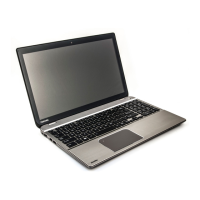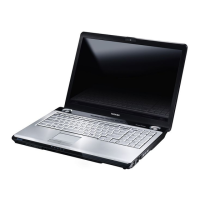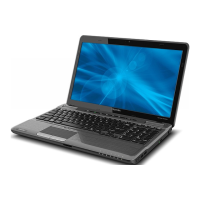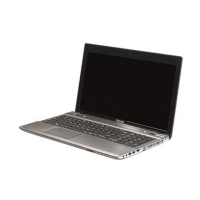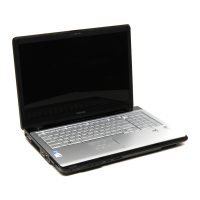
Do you have a question about the Toshiba Satellite P300 and is the answer not in the manual?
| Operating System | Windows Vista |
|---|---|
| Processor | Intel Core 2 Duo |
| RAM | Up to 4 GB |
| Storage | Up to 320 GB HDD |
| Graphics | ATI Mobility Radeon HD 3470 |
| Optical Drive | DVD SuperMulti |
| Wireless | 802.11a/g/n |
| LAN | 10/100 Ethernet |
| Ports | HDMI, VGA, ExpressCard |
Details the structure and organization of the user manual.
Explains formatting, symbols, and terminology used throughout the manual.
Lists all items included with the computer upon purchase.
Details the computer's hardware components and specifications.
Describes the software applications pre-installed on the computer.
Information on optional devices to enhance computer capabilities.
Illustrates the front panel of the computer with the display closed.
Details the ports and connectors located on the computer's left side.
Details the ports and connectors located on the computer's right side.
Shows the rear panel of the computer and its associated ports.
Illustrates the components found on the computer's underside.
Shows the front panel of the computer with the display open.
Explains how to use the computer's optical disc drive.
Step-by-step instructions for installing the computer's battery pack.
Guide on how to connect the AC power adapter to the computer.
Procedure for turning on the computer for initial use.
Information on using system recovery features and restoring software.
Instructions on how to use the touchpad for navigation and control.
Guide to enrolling and using the fingerprint sensor for authentication.
Instructions for operating the integrated webcam for capturing images.
How to load, unload, and operate the computer's optical disc drive.
Explanation of standard alphanumeric and symbol keys.
Using key combinations for quick access to system functions.
Describes the computer's power states and battery status LEDs.
Guidelines for safe handling, maintenance, and longevity of the battery.
Step-by-step instructions for removing and installing a battery pack.
How to launch the TOSHIBA HW Setup program.
Options for setting and managing user passwords for power-on.
How to set the order of devices for computer startup.
Information on installing and removing ExpressCards.
Instructions for installing additional RAM modules into the computer.
Steps to connect an external display device to the computer.
General guidelines for diagnosing and resolving computer issues effectively.
Basic checks to perform before detailed analysis of a problem.
Questions to help identify the root cause of a computer malfunction.
Checks for common hardware and system component problems.
Information on how to contact TOSHIBA for technical assistance.


